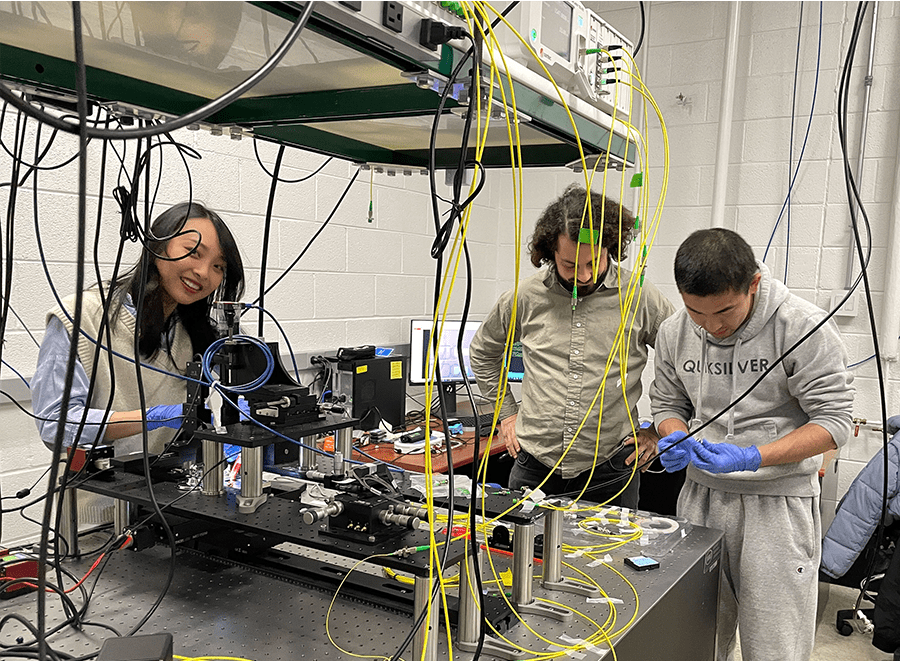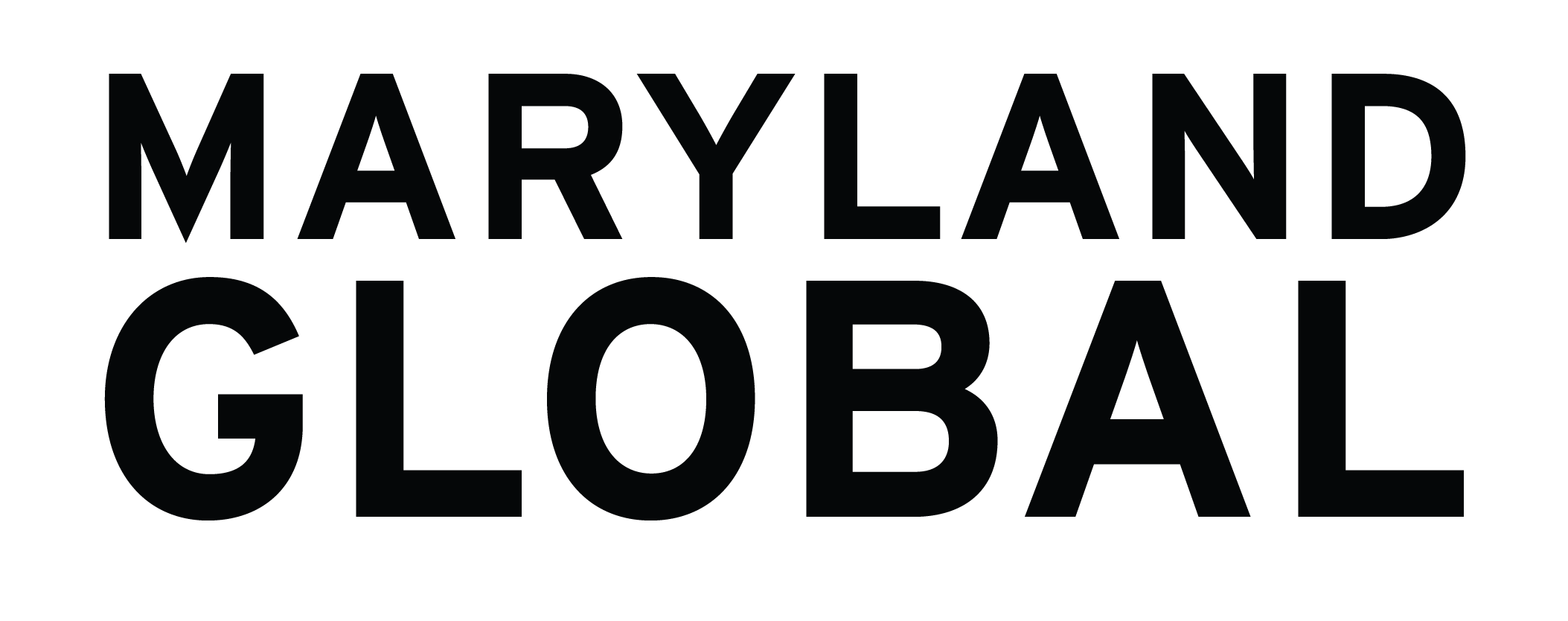
1. For those who may be unfamiliar with you and your work, can you share a little bit about yourself, your research interests at UMD, and the scope of your Fulbright?
I am a 2023-2024 Fulbright fellow from Greece, and spent the fall semester as a visiting scholar at the University of Maryland (UMD). My research focuses on creating ultra-fast, low-latency computer memory hardware, by exploiting the energy efficiency and broad-bandwidth capabilities of integrated photonics memories instead of electronics.
After a decade of research in the field of optical computing memories, my research group managed to develop the world’s fastest look-up memories, relying on InP photonic materials. These memories operate at speeds exceeding 10 Gb/s, which is roughly ten times faster than electronic look-up memory-solutions. The goal of developing integrated photonic memory architectures could enable rapid search operations in the stored data at the speed of light.
This can significantly increase the speed-related challenges and simultaneously reduce the energy consumption in applications like quick internet data-routing operations and data-security checks in cybersecurity firewalls, where Network operators and Data Center administrators need to search and check the validity of high-speed optical data-transmissions.
2. What inspired you to apply for a Fulbright scholarship? What was your process in approaching the application?
My research on computing hardware fits like a glove with the research and know-how generated at UMD on material sciences.
Achieving fast search operations at light speed addresses one aspect of computing. Energy consumption in computing and communication hardware is another significant concern. Prof. Carlos Rios Ocampo and our research group have made groundbreaking contributions in low energy consumption of photonic memories by focusing on the development of innovative Phase Change Materials (PCMs) embedded into silicon photonic waveguides. These materials can change their inner material structure, exhibiting different optical properties. Practically, this means that they can form optical computer memory cells that are programmed with data, stored and maintained without any additional external electrical supply. Our collaboration merges multiple fields (semiconductor physics, materials sciences, computer science, etc.) to develop fast search operations and computing at the speed of light, while not wasting valuable electrical power.
3. In 2022, the university released their new strategic plan, Fearlessly Forward. One of its core tenets is to take on the world's grand challenges. In what ways does your work contribute to supporting the common good?
To date, Networking equipment, Data Centers and Cloud Computing infrastructure that light up the Internet and our everyday virtual activities consume more electricity than entire countries, exceeding the power consumption of Colombia or Argentina and even competing with the UK. The huge energy waste of power-hungry communication infrastructure is expected to further exacerbate, as ‘Data never sleeps’ but instead continues to scale upwards relentlessly.
Fast, low-latency yet energy-efficient computing and networking equipment is working towards smarter and greener networks that promote a more sustainable network infrastructure, as well as higher quality of life for all. Consequently, fast look-up memory solutions bear promises to substantially increase optical switching and routing capacities, ideally without power-consuming electronic equipment, towards reducing its carbon footprints and more environmentally friendly ICT solutions.
Additionally, it facilitates the development of network infrastructure capable of hosting a larger number of interconnected devices and users, towards Internet of Things, where Internet-based applications and services are expected to impact and upgrade several aspects of our daily routines, such as smart homes, offices, e-health, e-government, educational facilities, communication networks, logistics, and big-data analysis.
4. What has been the most surprising finding in your research and scholarship?
Integrated photonics and optical sciences never stop to fascinate me. The collaborative spirit and attitude of the faculty and the strong support by the well-organized administrative processes of UMD have captivated my enthusiasm.
I had the pleasure of working at the Institute for Research in Electronics and Applied Physics, being offered an office and consumables directly from the first day of my visit, as well as being granted access to the lab, office equipment, news, email alerts or even a shuttle bus, without wasting any of my short (3-month only, and therefore precious) research visit. Missing laboratory equipment to perform some extra measurements has never been a limitation for us, as the colleagues of my research group and the other professors always offered to voluntarily identify the missing equipment in a neighboring lab and lend it for a few days. This has been one of the most supportive working environments I have ever encountered, allowing me and the rest of the graduate students and researchers to devote our time and strength to what we love most, research in photonics.
5. How do you plan to carry forward what you learned and the relationships you formed while abroad?
I have a rich knowledge of optical computing systems, optical switched networks and 5G/6G hardware tech, being at the forefront of European research and participating in various EU-research projects in information and communication technologies. I am currently affiliated as a senior researcher with the Wireless and Photonic Systems and Networks (WinPhoS) research group at the Center for Interdisciplinary Research and Innovation (KEDEK) of the Aristotle University of Thessaloniki (AUTH), and as an adjunct lecturer with the Department of Informatics at the University of Western Macedonia, both institutes being located in Northern Greece.
The knowledge gained during my Fulbright scholarship at UMD will be transferred to both Greek universities towards training EU-personnel in an emerging technology. This will occur in the form of mentoring several bachelor, master and Ph.D. students on Phase Change Materials and the physics that dictate their operation as photonic memories, as well as organizing short courses/seminars on experimental characterization of silicon photonic waveguides and switches with Phase Change Materials.
Being a member of two large Universities in Greece and a proud Fulbright alumnus offers the opportunity to act as a host for a bilateral exchange of US students or UMD faculty to Greece. I have already encouraged many UMD graduate students, with whom I interacted during my scholarship, to apply for a respective Fulbright US-scholarship and a research visit to Greece.
At this point, it is worth noting that this short article can act as an open call to any potential interested academic personnel (faculty/student) to express their interest for a Fulbright application. This aims to promote a more solid ‘research bridge’ connecting optical telecommunication - and computing - researchers in Northern Greece with the well-established and mature semiconductor fabrication processes and material sciences in UMD and the US, and greatly enhance new cross-Atlantic collaboration opportunities.
6. For others that are interested in becoming Fulbright scholars, what advice do you have for them?
Simply, go for it, the time is now!
Either as a visiting scholar at UMD and the US or becoming a US grantee seconded to Europe or anywhere throughout the world offers a unique, unparalleled educational, and inter-cultural experience. I truly enjoyed the great time and experiences here at the University of Maryland, being astonished by the well-established academic/university processes, the educational material, the research facilities and even the on-campus dining services.
It was certainly much more than just a scholarship for performing academic research in a different lab. It has been an enriching and enlightening experience, where I had the chance to experience a multi-national research and academic institute, working in an environment of distinctive equity and inclusion approach techniques, a transformative cultural and academic experience, with unrivaled support before, during and after the grant—a lifelong membership with tremendous networking opportunities. The overall hospitality of the UMD personnel was tremendous, with such a warm welcome to new visiting members, forming the frame of a fascinating experience that I will proudly promote.
_____
Visit our Fulbright Scholars gallery to meet our fearless scholars engaging with the world. For general program information and application guidance, visit our "How to Fulbright at Maryland" section at the bottom of the page. Interested in applying for your own Fulbright, or want to learn more about the program? Email UMD’s Fulbright U.S. Scholars liaison Scholten@umd.edu.
